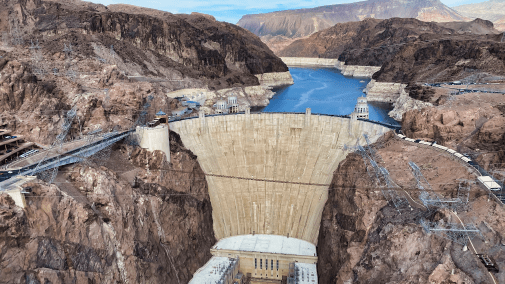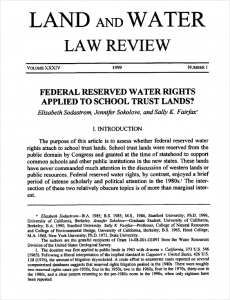Subscribe for a one-time fee of $495.00!

Water Rights & Resources
A highly editorialized and affordable database for understanding state & federal laws governing water.
4,183
TITLES
4,617
VOLUMES
890,619
PAGES
About the Water Rights & Resources Database
For those of us who take for granted the ready availability of water flowing from our taps, the concept of water rights may seem strange or confusing. Water rights refers to the right of a user to access water from a particular source. It is one facet of the complex network of water laws that address a multitude of facets over water at both the state and federal level. In the United States, water law focuses on both water use and protection. Learn more about water rights in our LibGuide!
HeinOnline’s Water Rights & Resources is an affordable, comprehensive, and timely collection that is dedicated to understanding the complex interplay of state and federal laws that govern all aspects of water in society, from municipal use to restoring its pristine condition. Collecting congressional documents, books, legislative histories on major legislation, and Supreme Court briefs on related cases, this database touches on a wide range of water issues, including irrigation, hydropower, riparian rights, water conservation, drinking water quality, and tribal water rights, encompassing the unique water rights issues that span from the Eastern seaboard to the Great Lakes and across the arid West. In the face of so much uncertainty, water rights and how to use our water resources becomes even more vital to understand.
- Highly Editorialized
- Most-Relevant and -Cited Articles
- Timely Resource
- 100% Subject-Coded
- Hundreds of Related Books
- Incredibly Affordable
- Updated Regularly
- Thousands of Government Documents
- One-Time Payment; No Subscription!
Title List: KBART (TXT) | CSV | HTML
Subject-Coded Content for Simplified Searching
To help users navigate the content spanning this extensive database, HeinOnline editors have created 16 new subjects. Explore these new subjects and their scope below:
The Clean Water Act, passed in 1972, is the primary federal law governing water pollution in the United States. Its reach is far: it bans the discharge of any pollutant into navigable rivers (without a permit), sets wastewater standards and water quality criteria, and sets a statutory definition for the term “waters of the United States.”
According to the Department of Energy, hydropower accounts for 6.3% of total U.S. electricity generation. Giant dams such as the Hoover Dam feature prominently in our conception of hydropower, but hydropower can be generated by small municipal facilities—or even through “damless” facilities.
Every other use and application of water is secondary in importance to the ready availability of clean water for drinking.
Find titles related to the ever-increasing scarcity of water.
A complex network of dams, levees, and dikes attempt to corral and control our nation’s rivers.
Groundwater is water that exists underground in cracks and spaces in soil, sand, and rock. According to the U.S. Geological Survey, groundwater is the source of about 40% of water used for public supplies and 39% of water used for agriculture in the U.S. For rural populations, groundwater provides drinking water for 90% of rural Americans who cannot get their water from a municipal water department.
This subject covers the cooperative international efforts to use, protect, and manage international waters, and water issues outside the United States.
Irrigation is vital to agriculture. It artificially supplies water to crops through various systems of tubes, pumps, and sprays, rather than relying on the unpredictable whims of weather and rainfall. According to the U.S. Geological Survey, it is estimated that about 70% of all the world’s freshwater withdrawals go towards irrigation.
In simple terms, an estuary is an area where a freshwater river or stream meets the ocean.
A river basin is the land that water crosses on its way to a river. Even if you do not see a river nearby, you live in a river basin. Actions upstream affect the water quality (and quantity) of the river or stream downstream. River basins drain into rivers, which flow into an estuary, and then into a larger lake or ocean.
Part of the convenience of modern life depends on our advances in plumbing and waste disposal. These modern marvels make up a central part of any nation’s water infrastructure. When they break down, it really, really stinks.
Find information on the mechanisms and large-scale projects by which water is stored and delivered for us.
Water management refers to the controlling water in such a way that its beneficial uses are maximized while its protentional harms, such as flooding, are minimized. Water management programs exist at both the state and federal level. Smarter water management programs, such as rainwater recovery and more efficient bathroom fixtures, will become more valuable as climate change makes water a more precious resource.
Topics covered under this subject include riparian and littoral rights, prior appropriation, tribal water rights, and disputes over water claims.
This subject covers issues of water delivery, water sources, and the technologies used to supply the thirsty masses with water.
Sometimes used interchangeably, a watershed is an area of land that drains all streams and rainfall into a common outlet. This can be the mouth of a bay or a reservoir. Although very similar to a river basin, a watershed is used to describe a smaller area of land that drains into a smaller body of water. Watersheds are found within a river basin.
Featured Content
Browse hundreds of books ranging in date from the 1800s to present day. Trace the history of water disputes in the western United States, explore the geological differences in water rights, and discover the similarities between the water problems of the present with those of the past.
Some titles you may want to check out include:
- A. H. Favour. Arizona’s Rights in the Colorado River: Proposals of Arizona and the Counter Proposals of California Submitted to the Tri-State Conference Now in Progress (1929).
- Wells A. Hutchins. Hawaiian System of Water Rights (1946).
- S. K. Love. Quality of Surface Waters of the United States, 1957: Parts 9-14, Colorado River Basin to Pacific Slope Basins in Oregon and Lower Columbia River Basin (1961).
- E. Boyd Wennergren. Value of Water for Boating Recreation (1965).
Committee Prints and Congressional Hearings
The deliberations of Congress provide insight both into issues requiring federal attention and their proposed solutions.
Some committee prints of note include:
- Assessing the nation’s water resources : issues and options : a report (1980)
- Groundwater contamination by toxic substances : a digest of reports : a report (1983)
- Proceedings of the Bottled Water Workshop (September 13 and 14, 1990) : a report (1990)
Some congressional hearings of note include:
- Addressing the Needs of Native Communities through Indian Water Rights Settlements (2015)
- Joint hearing on the Sierra Club’s proposal to drain Lake Powell or reduce its water storage capability (1998)
- Use of Technology and Innovation to Increase Water Security and Enable Economic Development in the West (2019)
CRS and GAO Reports
Some reports of note include:
Code of Federal Regulations
The Code of Federal Regulations (CFR) represents the current statutory positions of the federal government.
Published annually, the CFR is divided into 50 titles (aka topics, subjects, etc.) that are the codification of the general and permanent rules published in the Federal Register by the executive departments and agencies of the federal government.
Extracted within this database are the following relevant titles:
- CFR Title 18: Conservation of Power and Water Resources
- CFR Title 33: Navigation and Navigable Waters
Legislative Histories
Legislative histories present the journey of a bill as it becomes a law, with all its changes, additions, deletions and various legislative hurdles.
Some legislative histories of note included in this database are:
- Clean Water Act of 1977
- Legislative History of the Federal Water Power Act of 1920, P.L. 66-280
- Legislative History of the Safe Drinking Water Amendments of 1977, P.L. 95-190
Supreme Court Briefs
Access briefs filed in cases appearing before the U.S. Supreme Court on water law issues. These briefs contain the arguments and positions of parties in the cases.
Some of the briefs in this database include:
- Brief for Petitioner, Tarrant Regional Water District (in Tarrant Regional Water District, Petitioner v. Rudolf John Herrmann) (2012)
- Brief Amici Curiae of Association of California Water Agencies, et al. (in County of Maui v. Hawai’i Wildlife Fund; Sierra Club—Maui Group; Surfrider Foundation; West Maui Preservation Association) (2018)
- Brief for The National Assoc of Flood & Stormwater Management Agencies & the Santa Clara Valley Water District in Support of Petitioner (in Los Angeles County Flood Control District v. Natural Resources Defense Council, Inc. and Santa Monica Baykeeper) (2012)
Access hundreds of articles* selected by HeinOnline editors on water policy, environmental issues in water rights, indigenous water rights, riparian rights, reclamation projects, and more.
Or, dive into the bibliography to view a list of titles hand-picked by HeinOnline editors. Use the linked OCLC number to find a physical copy of the book at a library near you.
*In order to access the scholarly article links, you must be subscribed to the appropriate HeinOnline collection(s).
Browse various publications that serve as forums for the exchange of ideas, information, and legal and policy analyses concerning water law.

From the Pages of Library Journal

Pricing Information
Current HeinOnline Core Package Subscribers:
One-time payment of $495.00
Non-Subscribers:
First-year payment of $495.00
(annual renewal fee of $95.00)
